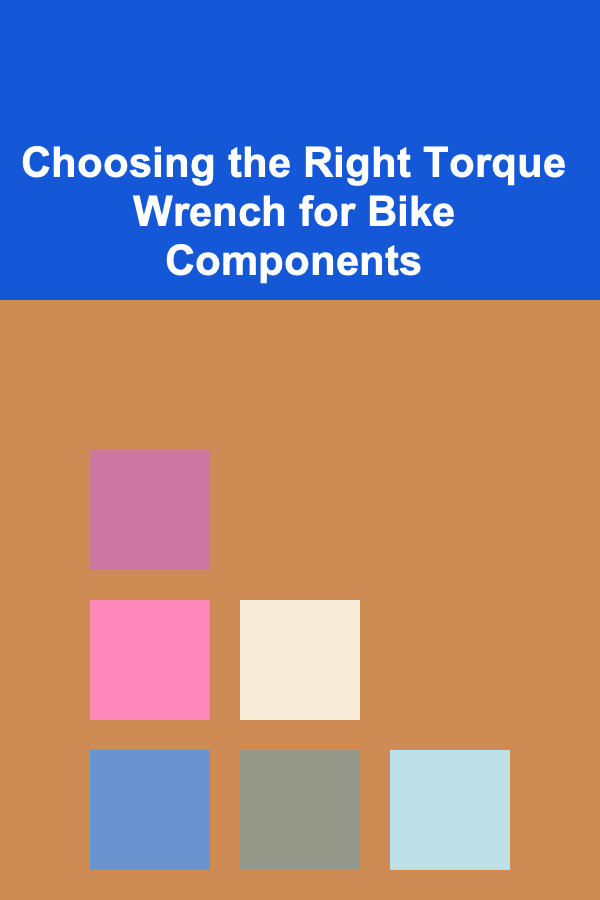
Choosing the Right Torque Wrench for Bike Components
ebook include PDF & Audio bundle (Micro Guide)
$12.99$11.99
Limited Time Offer! Order within the next:

In the world of cycling, precision is paramount. Whether you're a seasoned professional mechanic or a passionate home enthusiast, correctly tightening bolts on your bicycle components is crucial for performance, safety, and longevity. Overtightening can damage delicate carbon fiber parts, strip threads, or crush bearings, while undertightening can lead to component failure and potentially dangerous situations. The key to achieving this precision lies in using a torque wrench.
However, simply owning a torque wrench isn't enough. Selecting the correct torque wrench for specific bike components requires careful consideration of several factors. This article delves into the nuances of torque wrenches, exploring the different types available, the critical specifications to consider, and providing practical advice on how to choose the right tool for each specific job on your bicycle.
Why Torque Wrenches are Essential for Bike Maintenance
Before diving into the specifics of choosing the right torque wrench, it's important to understand why these tools are so essential in modern bike maintenance.
Preventing Damage
Modern bicycles, particularly high-end models, increasingly utilize lightweight materials like carbon fiber, aluminum alloys, and titanium. These materials are strong but also more susceptible to damage from overtightening. Carbon fiber, for instance, can be easily crushed or delaminated, leading to structural failure. Aluminum threads can be easily stripped, rendering components useless. A torque wrench allows you to apply the precise amount of force required by the manufacturer, preventing these costly and potentially dangerous scenarios.
Ensuring Component Performance and Longevity
Correctly tightened bolts ensure that components function as intended. For example, properly tightening a headset ensures smooth steering and prevents play, while correctly torquing bottom bracket bolts ensures efficient power transfer and prevents premature wear. Undertightened bolts can allow components to shift, vibrate, or even detach, leading to poor performance, accelerated wear, and potential accidents. A torque wrench helps maintain optimal performance and extend the lifespan of your bike components.
Safety First
Ultimately, the most crucial reason for using a torque wrench is safety. Loose components can lead to catastrophic failures, especially at high speeds or during challenging maneuvers. Properly tightened brakes, handlebars, stems, and seatposts are essential for control and stability. A torque wrench ensures that these critical components are securely fastened, providing you with a safer and more confident riding experience.
Types of Torque Wrenches
There are several types of torque wrenches available, each with its own advantages and disadvantages. Understanding these differences is crucial for making an informed decision.
Beam-Type Torque Wrenches
Beam-type torque wrenches are the simplest and most affordable type. They consist of a long beam with a scale and a pointer that indicates the applied torque. To use one, you apply force to the handle until the pointer reaches the desired torque value on the scale. This type of wrench is relatively inexpensive and doesn't require calibration, making it a good entry-level option.
Pros:
- Inexpensive
- Simple to use
- Doesn't require calibration
Cons:
- Can be difficult to read accurately, especially in tight spaces
- Less precise than other types
- Requires careful visual monitoring while tightening
Click-Type Torque Wrenches
Click-type torque wrenches are the most common type used in bike maintenance. They feature a mechanism that "clicks" or releases when the desired torque is reached, providing an audible and tactile signal. This allows you to apply the correct torque without having to constantly monitor a scale.
Pros:
- More accurate than beam-type wrenches
- Easy to use, especially in tight spaces
- Provides audible and tactile feedback
Cons:
- More expensive than beam-type wrenches
- Requires periodic calibration
- Can be damaged if overtorqued after the "click"
Digital Torque Wrenches
Digital torque wrenches are the most advanced type, featuring an electronic display that shows the applied torque in real-time. They often include features like programmable torque settings, audible alerts, and data logging capabilities. Digital torque wrenches offer the highest level of accuracy and precision.
Pros:
- Highly accurate and precise
- Easy to read digital display
- Programmable torque settings
- Data logging capabilities (on some models)
Cons:
- Most expensive type of torque wrench
- Requires batteries
- Can be more susceptible to damage from impact
Preset Torque Wrenches
Preset torque wrenches are designed to deliver a specific, predetermined torque value. They are often used in assembly lines or situations where repetitive tightening is required. While less versatile than other types, they ensure consistent and accurate torque application for a specific task.
Pros:
- Ensure consistent torque application
- Simple to use
Cons:
- Limited to a single torque value
- Not versatile for a variety of bike maintenance tasks
Key Specifications to Consider
Once you've decided on the type of torque wrench you need, there are several key specifications to consider to ensure you're choosing the right tool for your specific bike components.
Torque Range
The most important specification is the torque range of the wrench. Bike components typically require torque values ranging from a few Newton-meters (Nm) to upwards of 50 Nm. It's crucial to choose a wrench that covers the torque range required for the components you'll be working on. A common mistake is purchasing a wrench with a range that is too high, as accuracy is often reduced at the lower end of the scale. Many bike mechanics find it useful to have two torque wrenches: one with a low range (e.g., 2-20 Nm) for smaller bolts and delicate components, and another with a higher range (e.g., 10-60 Nm) for larger bolts and components that require more torque.
Drive Size
The drive size refers to the size of the square opening on the torque wrench that accepts sockets and extensions. Common drive sizes are 1/4 inch, 3/8 inch, and 1/2 inch. 1/4 inch and 3/8 inch drives are most common for bike maintenance, as they are suitable for the smaller bolts used on bicycles. Consider the sockets and extensions you already own when choosing a drive size, or factor in the cost of purchasing additional accessories.
Accuracy
Accuracy refers to the degree to which the torque wrench measures torque correctly. Torque wrench accuracy is typically expressed as a percentage (e.g., +/- 4%). A lower percentage indicates higher accuracy. For critical components, especially those made of carbon fiber, a highly accurate torque wrench is essential. Digital torque wrenches generally offer the highest accuracy, followed by click-type wrenches. Beam-type wrenches are typically the least accurate.
Length
The length of the torque wrench affects the amount of leverage you have. A longer wrench requires less force to achieve the same torque, but it can also be more difficult to maneuver in tight spaces. A shorter wrench provides more maneuverability but requires more force. Consider the accessibility of the bolts you'll be tightening when choosing the length of the wrench.
Calibration
All torque wrenches, except for beam-type, require periodic calibration to maintain accuracy. Click-type and digital torque wrenches should be calibrated regularly, typically every year or after a certain number of uses (as specified by the manufacturer). Calibration services are available at specialized tool shops or calibration labs. Some higher-end digital torque wrenches have self-calibration features.
Units of Measurement
Torque can be expressed in various units, including Newton-meters (Nm), inch-pounds (in-lb), and foot-pounds (ft-lb). Ensure that the torque wrench you choose displays the units you need. Newton-meters (Nm) are the most common unit used in bike maintenance. Some torque wrenches allow you to switch between different units.
Choosing the Right Torque Wrench for Specific Bike Components
Now that we've covered the different types of torque wrenches and their key specifications, let's look at how to choose the right wrench for specific bike components.
Stem and Handlebars
The stem and handlebars are critical components that require precise torque to ensure safety and control. Carbon fiber handlebars are particularly sensitive to overtightening. A low-range torque wrench (e.g., 2-20 Nm) with a 1/4 inch or 3/8 inch drive is ideal for these components. Accuracy is paramount, so a click-type or digital torque wrench is recommended. Always follow the manufacturer's recommended torque specifications, which are usually printed directly on the stem or handlebars.
Seatpost Clamp
The seatpost clamp is another area where precise torque is essential, especially with carbon fiber seatposts and frames. Overtightening can crush the seatpost or damage the frame, while undertightening can cause the seatpost to slip. A low-range torque wrench (e.g., 2-20 Nm) with a 1/4 inch or 3/8 inch drive is recommended. Use a click-type or digital torque wrench for accurate torque application.
Brake Calipers and Levers
Brake calipers and levers require careful torque application to ensure proper function and safety. Overtightening can damage the brake calipers or levers, while undertightening can lead to brake failure. A low-range torque wrench (e.g., 2-20 Nm) with a 1/4 inch or 3/8 inch drive is suitable for these components. Accuracy is crucial, so a click-type or digital torque wrench is recommended. Pay close attention to the manufacturer's recommended torque specifications for your specific brake system.
Derailleurs
Derailleurs, both front and rear, often have small bolts that require precise torque to ensure proper shifting performance. Overtightening can damage the derailleur or strip the threads, while undertightening can cause shifting problems. A low-range torque wrench (e.g., 2-20 Nm) with a 1/4 inch drive is ideal for these components. Accuracy is important, so a click-type or digital torque wrench is recommended.
Crankset and Bottom Bracket
The crankset and bottom bracket typically require higher torque values than other components. A higher-range torque wrench (e.g., 10-60 Nm) with a 3/8 inch or 1/2 inch drive is often necessary. A click-type torque wrench is generally sufficient for these components, but a digital torque wrench can provide even greater accuracy. Consult the manufacturer's specifications for the correct torque values for your specific crankset and bottom bracket.
Wheel Hubs and Bearings
Adjusting wheel hubs and bearing preload requires a delicate touch and often low torque values. Using a low-range torque wrench (e.g., 2-20 Nm) is essential to avoid overtightening and damaging the bearings. The specific tools and torque requirements vary significantly depending on the hub design, so consult the manufacturer's instructions carefully. Often, "feel" is more important than a specific torque value in this application, but using a torque wrench can prevent accidental overtightening.
Suspension Components
Suspension forks and rear shocks often have specific torque requirements for mounting bolts and adjustment knobs. Refer to the suspension manufacturer's specifications for the correct torque values and use a torque wrench that covers the required range. Some suspension components may require specialized torque tools or adapters.
Tips for Using a Torque Wrench Correctly
Even with the right torque wrench, it's important to use it correctly to ensure accurate torque application and prevent damage to your bike components.
Read the Instructions
Always read the manufacturer's instructions for both the torque wrench and the bike component you're working on. Pay attention to the recommended torque values, any specific instructions for tightening, and any warnings about potential hazards.
Use the Correct Socket or Bit
Use the correct size and type of socket or bit for the bolt you're tightening. A loose or ill-fitting socket can damage the bolt head and lead to inaccurate torque application.
Apply Smooth, Steady Pressure
Apply smooth, steady pressure to the torque wrench handle until the desired torque is reached. Avoid jerking or sudden movements, as this can lead to overtorquing.
Listen for the Click
With click-type torque wrenches, listen for the audible "click" that indicates the desired torque has been reached. Stop applying pressure immediately after the click to avoid overtorquing.
Don't Overtorque
Never continue applying pressure after the torque wrench has clicked. Overtorquing can damage the component or strip the threads. If you're unsure whether you've reached the correct torque, it's better to undertorque slightly and then re-tighten to the specified value.
Retorque After the First Ride
It's a good practice to retorque critical bolts, such as those on the stem, handlebars, and seatpost clamp, after the first ride. This allows the components to settle and ensures that the bolts remain securely fastened.
Store Your Torque Wrench Properly
Store your torque wrench in a safe and dry place, away from extreme temperatures and humidity. Click-type torque wrenches should be stored at their lowest torque setting to release the spring tension and prolong their lifespan.
Get your Wrench Calibrated Regularly
As mentioned earlier, regular calibration of your torque wrench is crucial for maintaining accuracy. Follow the manufacturer's recommendations for calibration intervals and use a reputable calibration service.
Beyond the Wrench: Other Important Considerations
While a torque wrench is essential, there are other factors that contribute to successful bike maintenance.
Proper Bolt Preparation
Before tightening any bolt, ensure that the threads are clean and lubricated. Use a thread locker (e.g., Loctite) where recommended by the manufacturer to prevent loosening. For components made of dissimilar metals (e.g., aluminum bolts in a carbon fiber frame), use an anti-seize compound to prevent galvanic corrosion.
Understanding Bolt Grades
Bolts are graded based on their strength and material. Replacing a bolt with one of a lower grade can compromise the safety and integrity of the component. Always use replacement bolts that meet or exceed the original specifications.
Patience and Attention to Detail
Bike maintenance requires patience and attention to detail. Rushing through the process can lead to mistakes and potentially dangerous situations. Take your time, double-check your work, and always prioritize safety.
Conclusion
Choosing the right torque wrench for bike components is an investment in your bike's performance, longevity, and your own safety. By understanding the different types of torque wrenches, considering the key specifications, and following the tips outlined in this article, you can confidently tighten bolts to the correct torque and enjoy a safer and more enjoyable riding experience. Remember that a torque wrench is a precision instrument, and using it correctly requires knowledge, patience, and a commitment to doing things right. Happy wrenching!

How to Create a Time Management Checklist for Time Blocking
Read More
How To Share a Meal Respectfully in Any Culture
Read More
How to Reduce Your Exposure to Indoor Pollutants
Read More
How To Master the Ancient Wisdom of the Stoics
Read More
How To Learn Mobile Game Development
Read More
How to Use Social Media for Product Launches: A Comprehensive Guide
Read MoreOther Products

How to Create a Time Management Checklist for Time Blocking
Read More
How To Share a Meal Respectfully in Any Culture
Read More
How to Reduce Your Exposure to Indoor Pollutants
Read More
How To Master the Ancient Wisdom of the Stoics
Read More
How To Learn Mobile Game Development
Read More